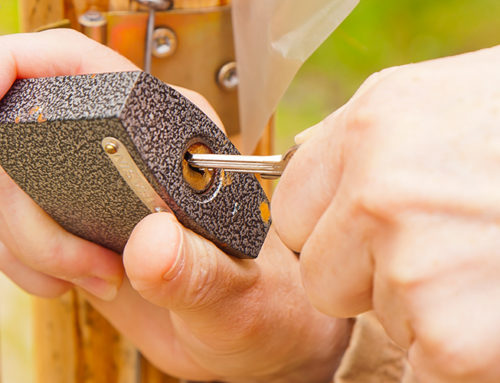The world of security and locksmithing has been profoundly shaped by remarkable figures. Linus Yale Jr. revolutionized the industry with his improvements to the pin tumbler lock. Joseph Bramah introduced the Bramah lock, a benchmark in security. Jeremiah Chubb’s Detector Lock advanced tamper detection. Robert Barron’s double-acting tumbler lock laid foundational principles. Charles Courtney enhanced safe security, while Alfred C. Hobbs illuminated vulnerabilities in existing locks. John Chubb made a substantial contribution to secure lock and safe mechanisms. These pioneers, among others, have driven the evolution from mechanical locks to modern, sophisticated security systems. Continue exploring to discover their enduring legacies.
Introduction
The evolution of security mechanisms has been profoundly influenced by historical figures whose innovative contributions have shaped the world of locks and safeguards. This article aims to educate readers about these pioneering individuals and their lasting impact on modern locksmithing and security systems. By exploring their legacies, we gain a deeper appreciation for the intricate craftsmanship and advanced technologies that protect our valuables today.
Overview of the importance of security throughout history
From the earliest days of human civilization, security has been an indispensable element in the protection of life, property, and information. Ancient civilizations like Egypt, Greece, and Rome laid the foundation for early security measures, reflecting a timeless need for protection. Over centuries, the evolution of locks and safeguards has mirrored humanity’s enduring quest to secure valuables and assets. This historical journey reveals how security has adapted to technological advancements, from rudimentary lock mechanisms to sophisticated high-tech solutions. Understanding the importance of security throughout history not only underscores its pivotal role in societal development but also highlights how innovations in this field have continuously shaped our world, ensuring safety and peace of mind for generations.
Brief mention of the contributions of key historical figures in the evolution of security and locks
Pioneering minds like Pharaoh Khafre, Linus Yale Jr., and Joseph Bramah have indelibly influenced the evolution of lock and security systems through their groundbreaking innovations. Pharaoh Khafre’s ancient pin-tumbler lock laid the foundation for modern security mechanisms. Linus Yale Jr.’s refinement of the double-acting pin tumbler lock introduced unprecedented precision and reliability. Joseph Bramah’s H-cut lever design revolutionized lock security, setting new standards. Further advancements came from Jeremiah Chubb’s detector lock and Robert Barron’s double-acting lever lock. Vivant Denon contributed to lock technology, while Alfred Charles Hobbs famously picked the Bramah lock, challenging existing standards. Henry Robinson Towne’s partnership with Yale and Marc Weber Tobias’ vulnerability research, along with James Sargent’s Magnet Bank Lock, illustrate the continuous evolution in security.
Purpose of the blog post: to educate and highlight the impact of these figures on modern locksmithing and security
Understanding the contributions of historical figures such as Linus Yale Jr. and Joseph Bramah is essential for appreciating the profound advancements in modern locksmithing and security systems. Yale’s invention of the modern pin tumbler lock in 1860, and Bramah’s enhancement of the lever lock with his H-cut design, laid the foundation for today’s sophisticated security mechanisms. This blog post aims to educate and emphasize how these pioneers’ innovations directly influence contemporary lock designs and safeguarding strategies. By exploring the inventive leaps made by Robert Barron, Abraham O. Stansbury, and Jeremiah Chubb, we can trace the lineage of security technology and recognize the enduring impact of their groundbreaking work on modern locksmithing practices and the overall security industry.
Linus Yale Jr.: The Father of the Modern Lock
Linus Yale Jr., born into a family deeply invested in the art of lock-making, revolutionized security with his invention of the modern pin tumbler lock in 1860. His innovative designs not only set new standards for lock mechanisms but also paved the way for advancements in high-security solutions like deadbolt installations. Yale’s legacy endures as his fundamental concepts continue to underpin contemporary lock technology.
Biography and early life
Born into a family with a rich legacy in lock-making, Linus Yale Jr. grew up with a profound exposure to the intricacies of security mechanisms, setting the stage for his groundbreaking contributions to modern lock technology. His father, Linus Yale Sr., was an esteemed inventor himself, pioneering advancements in lock design that clearly influenced the young Yale. From an early age, Linus Jr. exhibited an insatiable curiosity and a meticulous attention to detail, traits that would later define his career. He was particularly fascinated by combination locks for safes, demonstrating his diverse expertise and innovative spirit. Yale’s early life was marked by an enduring quest for perfection, driven by an acute awareness of the vulnerabilities inherent in existing security systems.
Invention of the pin tumbler lock
Building upon the foundational knowledge and experience inherited from his father, Linus Yale Jr. revolutionized the security industry in 1860 with the invention of the modern pin tumbler lock. This groundbreaking innovation employed pins of varying lengths, meticulously designed to match the unique cuts on a key. This configuration drastically enhanced security by making unauthorized access nearly impossible without the correct key. Yale’s design was a masterstroke of precision engineering, providing a reliable mechanism that set a new standard in lock technology. His pin tumbler lock not only laid the groundwork for modern security systems but also showcased his exceptional ingenuity, solidifying his legacy as the father of the modern lock.
Legacy and influence on modern lock designs
Pioneering advancements in lock technology, Linus Yale Jr.’s innovative designs have left an indelible mark on modern security systems, influencing nearly every aspect of contemporary lock mechanics. Credited with inventing the modern pin tumbler lock in 1860, Yale Jr. revolutionized lock security by creating a mechanism that remains foundational to key lock designs today. His legacy is further cemented by his keen interest in combination locks for safes, showcasing his broad expertise in security solutions. Yale’s work, building on the contributions of his father, Linus Yale Sr., underscores a relentless pursuit of improvement, stressing the need for continual advancement in lock technology to meet evolving security demands. This enduring impact secures Yale Jr.’s place as the father of modern lock design.
Link to services like deadbolt installation and high-security locks
Recognizing the profound impact of Linus Yale Jr.’s innovations on modern lock technology, today’s security services offer advanced solutions such as deadbolt installation and high-security locks that draw directly from his pioneering designs. Yale Jr.’s invention of the pin tumbler lock in 1860, featuring pins of varying lengths, revolutionized lock security and laid the groundwork for contemporary high-security mechanisms. These sophisticated locks incorporate his principles to provide robust protection, guaranteeing enhanced security for homes and businesses. Modern deadbolts and high-security locks embody Yale’s commitment to continuous improvement, offering unparalleled resistance to tampering. For those seeking top-tier security solutions, professional installation services ensure that the legacy of Linus Yale Jr.’s innovations continues to safeguard properties effectively.
Joseph Bramah: The Innovator of the Bramah Lock

Joseph Bramah revolutionized lock security with his innovative design that featured H-shaped lever cuts, greatly enhancing resistance to tampering. His Bramah lock, renowned for its intricate key mechanism, set new standards in burglary prevention and paved the way for modern secure locking systems. Bramah’s contributions extend beyond locks, as his engineering ingenuity also led to the invention of the hydraulic press and advancements in water closet design, underscoring his legacy in security and mechanical innovation.
Background and contributions to lock design
An innovator in the field of security, Joseph Bramah revolutionized lock design with his introduction of the H-cut lever, setting a new standard for burglary-resistant mechanisms. Bramah’s pioneering lever lock design incorporated a unique key system that greatly enhanced security by resisting break-in attempts, a feat previously unachieved in the industry. His meticulous craftsmanship and visionary approach to lock engineering not only thwarted manipulation but also laid the groundwork for future advancements in lock security. By addressing the vulnerabilities of existing locks, Bramah’s contributions elevated the standards of safeguarding valuables, marking a pivotal milestone in the evolution of secure locking mechanisms. His legacy endures, influencing modern lock designs and continuing to inspire innovation in the field of security.
Details of the Bramah lock and its security features
Building upon his foundational innovations, the Bramah lock’s security features exemplify a masterful combination of complexity and precision, setting a new benchmark in the domain of secure locking mechanisms. Central to its design is the H-cut lever, which introduced a unique key pattern resistant to break-in attempts. This mechanism, incorporating multiple levers, required intricate alignment to function, vastly improving burglary resistance. The lock’s complexity demanded a specific key, making unauthorized duplication exceedingly difficult. Bramah’s lock design not only challenged the perceived invincibility of contemporary locks but also heralded a new era of security. Its intricacy and efficacy in safeguarding assets underscored Joseph Bramah’s role as a true pioneer in the field of secure locking systems.
How Bramah’s innovations paved the way for modern secure locks
Bramah’s groundbreaking innovations in lock design have profoundly influenced the evolution of modern secure locking systems, establishing a pivotal legacy of enhanced security and technological advancement. By incorporating the distinctive H-cut on the lever, Joseph Bramah significantly improved the lever lock’s resistance to break-ins and manipulation. This meticulous enhancement not only thwarted unauthorized access but also introduced a new era of sophisticated key mechanisms that set unparalleled security standards. Bramah’s relentless pursuit of perfection and his contributions to lock design challenged traditional perceptions of invincibility, laying an essential foundation for the development of contemporary secure locks. His pioneering work remains a testament to the importance of innovative security features in the ever-evolving landscape of safeguarding assets.
Link to services like cylinder locks and mortise locks
Joseph Bramah’s pioneering innovations in lock mechanisms not only revolutionized the security landscape of his era but also laid the groundwork for modern advancements in cylinder locks and mortise locks. By introducing the H-cut lever, Bramah enhanced security against break-ins, crafting unique keys that resisted traditional picking methods. This design principle became a cornerstone for the reliability and robustness seen in today’s high-security cylinder and mortise locks. The Bramah Lock’s exceptional resistance to unauthorized access set new industry standards, influencing contemporary lock technologies. His meticulous engineering guaranteed that modern locks continue to benefit from his foundational work, intertwining Bramah’s legacy with today’s sophisticated locking systems, and ensuring that security remains a paramount consideration in lock design.
Jeremiah Chubb: The Developer of the Detector Lock
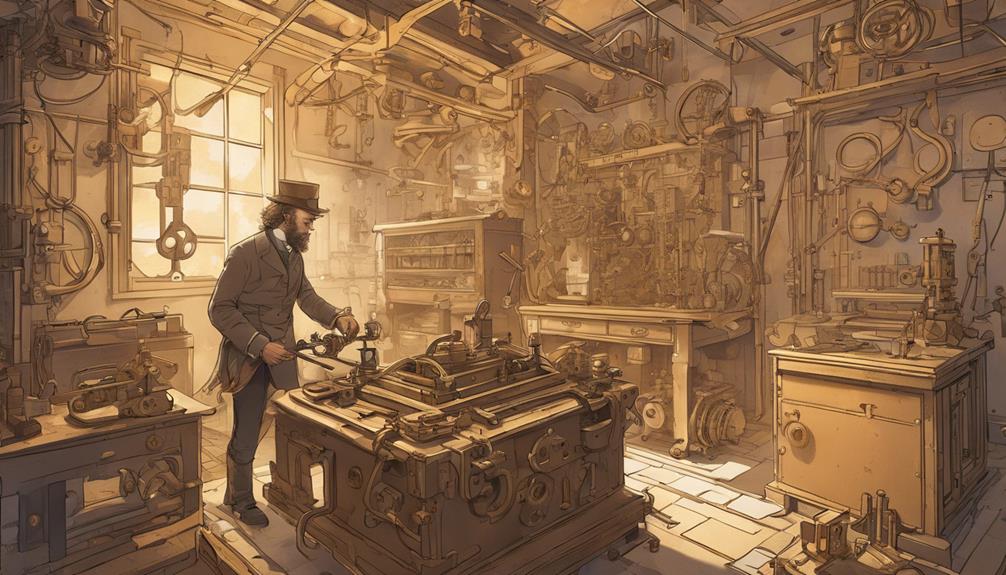
Jeremiah Chubb’s ingenious creation of the Chubb detector lock revolutionized security with its multiple double-acting levers and step pattern key, offering unprecedented protection against unauthorized access. This lock, which remained unpickable for nearly 30 years, not only safeguarded valuables but also set a new standard in the locksmithing industry. Chubb’s legacy endures today, influencing modern lock rekeying and safe services, and cementing his status as a pivotal figure in the evolution of security mechanisms.
Life story and career highlights
Developing the innovative detector lock, Jeremiah Chubb revolutionized the world of lock security with his intricate design featuring multiple double-acting levers. Born in 1793, Chubb’s early fascination with mechanics culminated in his groundbreaking invention in 1818. His career highlights include securing a patent for his detector lock, which remained unpickable for three decades. The lock’s step-pattern key was a marvel, preventing unauthorized access by resetting internal levers after tampering attempts. Chubb’s relentless pursuit of security excellence greatly enhanced protection for safes and valuables. His contributions were not just technical marvels but also set new industry standards, ensuring his legacy as a pivotal figure in the evolution of lock and safeguard technology.
Creation and significance of the Chubb detector lock
The creation of the Chubb detector lock marked a pivotal moment in lock security, introducing an intricate mechanism with multiple double-acting levers and a step pattern key that greatly advanced protection against unauthorized access. Jeremiah Chubb’s innovative design included a unique feature that required the specific key to reset the levers after any attempted break-in, thereby alerting the owner to tampering. This lock was heralded as unpickable for three decades, setting unprecedented standards for security. By enhancing the protection of safes and vaults, the Chubb detector lock became a cornerstone in safeguarding valuables, influencing future lock technology advancements. Chubb’s contribution ensured a leap forward in the efficacy and reliability of locks, making them nearly impregnable.
Impact on locksmithing and security industries
Chubb’s revolutionary detector lock had a profound impact on the locksmithing and security industries, setting a new benchmark for mechanical security systems with its advanced design and tamper-evident features. Utilizing multiple double-acting levers and a unique step pattern key, Chubb’s lock introduced an unprecedented level of security. Importantly, it required a specific key to reset the levers after a break-in attempt, preventing unauthorized access and deterring tampering. This innovative design was considered unpickable for three decades, a demonstration of its superior craftsmanship. Chubb’s contributions did not just enhance the protection of valuables and safes; they fundamentally transformed the standards and practices within the locksmithing industry, pushing the boundaries of what was technologically achievable in lock security.
Link to services such as lock rekeying and locksmith services for safes
Jeremiah Chubb’s detector lock not only revolutionized mechanical security but also laid the groundwork for modern locksmith services, including lock rekeying and specialized safe protection, by introducing advanced tamper-evident mechanisms and resetting keys. Chubb’s innovative design, with its multiple levers and specific resetting key, made locks more resilient against tampering, necessitating professional rekeying services when breaches were attempted. This pioneering technology, considered unpickable for 30 years, set new standards in the security industry, ensuring that safes and valuable possessions remained protected. Today, locksmiths build upon Chubb’s legacy, providing tailored services to maintain and enhance the security of modern locking systems, ensuring peace of mind for clients safeguarding their most precious assets.
Robert Barron: The Creator of the Double-Acting Tumbler Lock
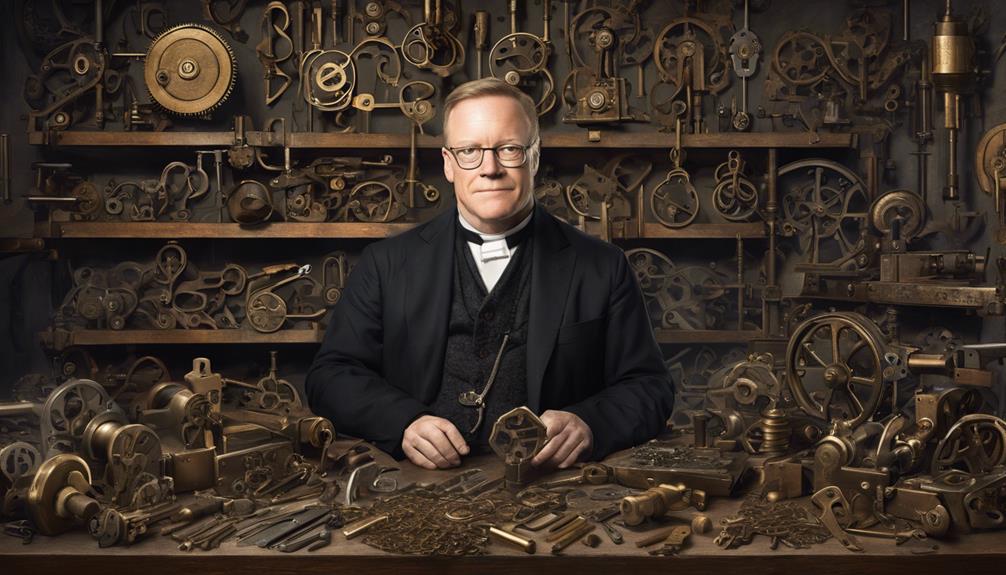
Robert Barron’s creation of the double-acting tumbler lock in the late 18th century revolutionized the field of security by introducing a mechanism that required a key to lift a lever and grip the bolt, thereby greatly enhancing lock integrity. Prior to Barron’s innovation, locks were susceptible to unauthorized access, making his design a pivotal advancement in safeguarding assets. This invention not only set a new standard for lock security but also influenced modern residential and commercial lock installations, underscoring Barron’s lasting impact on the industry.
Biography and early influences
The life and work of the ingenious inventor Robert Barron are pivotal in the history of lock security, particularly with his revolutionary creation of the double-acting lever lock. Born in the late 18th century, Barron was deeply influenced by the rampant lock-picking practices of his time. His early exposure to the vulnerabilities of existing locks ignited his passion for enhancing security mechanisms. Barron’s technical acumen, combined with an insatiable curiosity, led him to innovate beyond traditional designs. His environment, steeped in the industrial advancements of the era, provided him with the tools and inspiration necessary to rethink lock security fundamentally. This backdrop cultivated Barron’s ingenuity, ultimately resulting in his groundbreaking double-acting lever lock that forever transformed the field.
The double-acting tumbler lock and its advancements in security
Barron’s groundbreaking invention of the double-acting tumbler lock introduced a revolutionary mechanism that greatly enhanced lock security by requiring a key to precisely manipulate internal components to open the lock. Prior to Barron’s innovation, locks could be easily compromised, but his design demanded the key to lift a lever, grip the bolt, and pull it back, providing a robust defense against unauthorized entry. This meticulous mechanism addressed the vulnerabilities of previous locks, marking a significant advancement in protecting valuables and properties. Barron’s double-acting tumbler lock not only set new standards in security but also illustrated his profound understanding of mechanical intricacies, ensuring that locks were more resilient and trustworthy than ever before.
Influence on subsequent lock designs and security measures
By pioneering the double-acting tumbler lock, Robert Barron catalyzed a profound evolution in lock design and security measures that would influence countless innovations in the field. His groundbreaking design introduced the concept of using a key to lift a lever, grip the bolt, and pull it back, securely opening the lock. Prior to Barron’s invention, locks were alarmingly susceptible to being opened without keys, exposing a significant vulnerability. Barron’s mechanism fundamentally addressed these security flaws, establishing a new standard for lock integrity. This advancement not only enhanced protection against unauthorized access but also set the stage for more sophisticated locking systems. The double-acting tumbler lock remains a cornerstone in the annals of security technology, inspiring future developments in the industry.
Link to services like residential and commercial lock installations
As Robert Barron’s double-acting tumbler lock established a new benchmark in security technology, it paved the way for modern residential and commercial lock installations, influencing contemporary locksmith services. This revolutionary design required a key to lift the lever and retract the bolt, reducing the risk of unauthorized access to a great extent. Prior to Barron’s innovation, many locks were vulnerable to manipulation, but his double-acting mechanism provided enhanced security and reliability. Today, the principles behind Barron’s lock are foundational in the locksmith industry, guiding the development of sophisticated locking systems used in homes and businesses. Locksmiths now adopt advanced variations of Barron’s design to offer robust security solutions, ensuring that properties remain secured against modern threats.
Alfred Charles Hobbs: The Man Who Picked the Unpickable Lock

Alfred Charles Hobbs revolutionized the locksmithing world by famously picking both the Bramah and Chubb locks at the Great Exhibition of 1851, an achievement that underscored his exceptional technical prowess. This groundbreaking feat not only highlighted critical vulnerabilities in what were considered impenetrable locks but also catalyzed significant advancements in lock design and security standards. Hobbs’ legacy continues to influence modern locksmithing practices and emergency lockout services by underscoring the perpetual need for innovation in security mechanisms.
Professional journey and key achievements
With a skill that would reverberate through the annals of lock security, Alfred Charles Hobbs commenced on a professional journey marked by his groundbreaking achievement of picking the vaunted Bramah lock, a feat that forever altered the landscape of lock design and security. His demonstration of picking the supposedly unpickable lock exposed critical vulnerabilities, challenging the prevailing perception of lock invincibility. This pivotal moment in Hobbs’ career underscored the necessity for more robust lock mechanisms and spurred significant advancements in lock technology. By highlighting these weaknesses, Hobbs played an essential role in the evolution of lock security, demonstrating that continuous innovation and improvement were imperative. His technical expertise and daring exploits have left an indelible mark on the field of locksmithing.
The great exhibition challenge and picking the Bramah and Chubb locks
The zenith of Alfred Charles Hobbs‘ illustrious career was unquestionably his audacious demonstration at the Great Exhibition of 1851, where he successfully picked both the Bramah and Chubb locks, revealing critical flaws in these renowned security mechanisms and propelling the field of lock technology into a new era of innovation and rigor. Hobbs meticulously exposed vulnerabilities within the Bramah lock, previously deemed unpickable, dismantling its reputation for invincibility. This feat underscored the imperative of continuous advancement in lock design to thwart potential breaches. By adeptly maneuvering through the intricate mechanisms of both locks, Hobbs not only cemented his legacy but also underscored the necessity for ongoing enhancement in lock security, catalyzing profound developments in safeguarding technologies.
Impact on the locksmithing industry and lock security standards
Hobbs’ audacious feat of picking the Bramah lock not only sent shockwaves through the locksmithing industry but also precipitated a paradigm shift in lock security standards, compelling manufacturers to innovate and fortify their designs against future breaches. This groundbreaking act dismantled the myth of the unpickable lock, exposing critical vulnerabilities in existing mechanisms. Manufacturers were driven to enhance their technologies, incorporating more sophisticated and intricate designs to thwart potential tampering. Hobbs’ expertise in lock manipulation wasn’t merely a challenge; it was a catalyst for progress, pushing the boundaries of lock security technology. His influence spurred a relentless pursuit of perfection in the industry, ensuring that locks evolved in complexity and resilience, ultimately safeguarding society’s valuables with unprecedented reliability.
Link to services like lock picking and emergency lockout assistance
Alfred Charles Hobbs’ extraordinary ability to pick the formidable Bramah lock not only revolutionized lock security but also laid the groundwork for modern services like professional lock picking and emergency lockout assistance. By exposing the vulnerabilities in a lock deemed invincible, Hobbs prompted a reevaluation of lock security standards, propelling advancements in lock technology. His demonstration underscored the necessity for stronger, more secure mechanisms, ultimately influencing today’s industry practices. Professional locksmiths now rely on the principles Hobbs revealed to provide critical services, such as emergency lockout assistance and security assessments. This legacy guarantees that continuous improvement remains at the heart of lock security, offering peace of mind to individuals and businesses alike.
Harry Soref: Founder of Master Lock

Harry Soref, the visionary founder of Master Lock in 1921, revolutionized the lock industry with his innovative laminated steel padlock, offering unprecedented security and durability. His contributions greatly advanced lock manufacturing, leading to a global expansion that now encompasses a diverse range of security products, including padlock installation and key duplication services. Soref’s enduring legacy is evident as Master Lock continues to set the benchmark for quality and reliability in the security industry.
Early life and founding of Master Lock company
From humble beginnings as a skilled locksmith and inventor, Harry Soref founded the Master Lock Company in 1921 in Milwaukee, Wisconsin, revolutionizing the lock industry with his innovative designs. Soref’s early life was marked by a passion for mechanical ingenuity and a keen interest in security solutions. His hands-on experience in locksmithing provided him with the technical expertise necessary to envision robust, reliable locks. The Master Lock Company quickly gained a reputation for producing high-quality padlocks, setting new standards in the industry. Soref’s unwavering commitment to durability and security established Master Lock as a trusted name in safeguarding valuables. His pioneering spirit and relentless pursuit of excellence laid the groundwork for a lasting legacy in the world of security.
Invention of the laminated steel padlock
In 1921, the lock industry witnessed a groundbreaking advancement with the invention of the laminated steel padlock, a creation that showcased Harry Soref’s ingenuity and set new benchmarks for security and durability. As the founder of Master Lock, Soref revolutionized padlock design by introducing multiple layers of steel riveted together, enhancing both strength and security. This innovative approach not only increased the padlock’s durability but also made it a popular choice for safeguarding various items. Soref’s laminated steel padlock quickly became synonymous with robust construction, laying the foundation for modern padlock designs that prioritize strength and longevity. His invention remains a reflection of his vision and technical prowess in the field of security solutions.
Contributions to lock manufacturing and security products
Building on the success of the laminated steel padlock, Harry Soref’s contributions to lock manufacturing and security products fundamentally transformed the industry, establishing new standards for durability and reliability that continue to influence modern security solutions. Soref’s innovative designs and engineering prowess led to advancements that safeguarded valuables and property with unprecedented strength. His commitment to high-quality materials and meticulous craftsmanship guaranteed that Master Lock became synonymous with trust and security. The introduction of robust, tamper-resistant padlocks showcased his technical expertise and visionary approach, setting a benchmark for future developments in the industry. Today, Soref’s legacy endures, as his pioneering efforts in lock technology remain integral to the design and functionality of contemporary security products.
Link to services such as padlock installation and key duplication
Harry Soref’s pioneering work with Master Lock not only revolutionized padlock design but also laid the foundation for essential services such as padlock installation and key duplication, ensuring thorough security solutions for both individuals and businesses. By introducing the laminated steel padlock, Soref provided a robust and reliable security measure that quickly became the industry standard. His foresight extended beyond product innovation, recognizing the necessity of ancillary services like key duplication to enhance user convenience and accessibility. Master Lock’s commitment to quality and reliability in these services has solidified its reputation as a leader in security solutions. Soref’s legacy endures, as his contributions continue to influence modern security practices, offering peace of mind to countless users worldwide.
Linus Yale Sr.: The Pioneer of Bank Locks
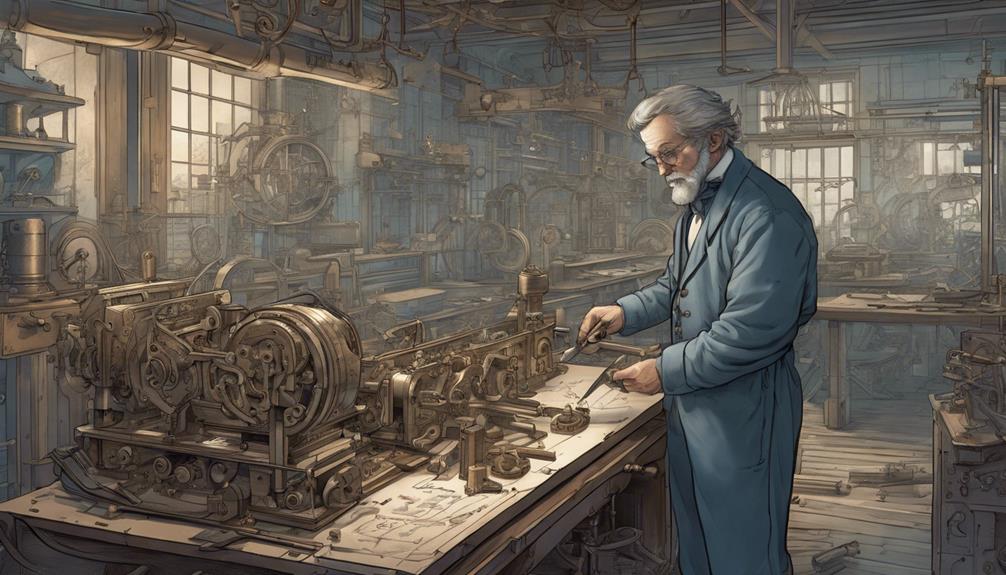
Linus Yale Sr. stands as a pivotal figure in the evolution of bank security, renowned for his pioneering work in lock and key technology during the 19th century. His development of the original pin tumbler lock not only revolutionized the security industry but also established new standards for safeguarding valuable assets. Yale Sr.’s innovations continue to impact modern-day commercial locksmith services and high-security lock installations worldwide.
Overview of his life and career
Renowned for his groundbreaking contributions to bank security, Linus Yale Sr.’s career was marked by a relentless pursuit of innovation in lock design. His profound expertise in lock mechanisms led to the introduction of advanced security solutions that transformed the banking industry. Yale Sr. dedicated his life to enhancing the safety of financial institutions, setting unprecedented benchmarks for safeguarding assets. His meticulous approach and technical prowess established him as a key figure in the evolution of secure storage. The legacy of trust and reliability he built continues to influence modern bank lock systems. Yale Sr.’s pioneering work not only protected invaluable assets but also laid a robust foundation for future advancements in bank security.
Development of the original pin tumbler lock
Building on his illustrious career in bank security, the development of the original pin tumbler lock stands as a proof of Linus Yale Sr.’s ingenuity and technical mastery. His innovative design laid a robust foundation for modern security systems, revolutionizing the industry by making locks notably more reliable and secure. The intricate mechanism of the pin tumbler lock, with its precise alignment of pins and cylinders, showcased Yale Sr.’s unparalleled technical expertise. This design quickly became the industry standard, acclaimed for its effectiveness in safeguarding valuables. Yale Sr.’s contributions to lock mechanisms not only enhanced the integrity of security systems but also set the stage for future advancements, cementing his legacy as a pioneer in the field of lock security.
Contributions to bank lock security and innovations
A towering figure in the domain of bank security, Linus Yale Sr. transformed the landscape with his groundbreaking innovations in bank lock technology. His inventive designs revolutionized the security of bank vaults and safes, setting new industry standards for protecting valuable assets. Yale Sr.’s contributions are not merely historical footnotes but foundational elements that continue to impact modern secure storage solutions. His pioneering work in creating durable, reliable bank locks has left an indelible mark on the evolution of secure storage systems globally. By enhancing the robustness and reliability of bank locks, Yale Sr. guaranteed that his legacy would persist, shaping the future of bank security and inspiring ongoing advancements in the field.
Link to services like commercial locksmith services and high-security lock installations
Linus Yale Sr.’s revolutionary advancements in bank lock technology have become the cornerstone for modern commercial locksmith services and high-security lock installations. By designing robust bank locks that set unprecedented standards for safeguarding assets, Yale Sr.’s innovations directly influenced the development of today’s sophisticated locking mechanisms. Commercial locksmiths now rely heavily on the principles established by Yale, ensuring that financial institutions are protected with cutting-edge technology derived from his pioneering work. High-security lock installations today embody the precision and reliability that Yale envisioned, providing unparalleled protection for valuables. The legacy of Linus Yale Sr. continues to thrive, as his contributions remain integral to the security industry, guaranteeing peace of mind for businesses and individuals alike.
Charles Courtney: The Locksmith Who Advanced Safe Security

Charles Courtney, a revered locksmith, revolutionized the field of safe security through his groundbreaking advancements in locking mechanisms, profoundly enhancing the protection of valuable assets. His career is marked by significant contributions that not only bolstered the security of safes and vaults but also influenced the trajectory of modern safeguarding techniques. Courtney’s expertise continues to underpin contemporary practices in safe installation and repair services, making his legacy indispensable to the industry.
Life story and locksmithing career
Frequently hailed as a pioneer in the field of safe security, Charles Courtney’s locksmithing career is marked by groundbreaking advancements that have left an indelible mark on modern security practices. Born into a family of craftsmen, Courtney’s early fascination with mechanical intricacies led him to pursue locksmithing with fervor. His journey was characterized by an unyielding commitment to excellence and innovation. Courtney’s work primarily focused on enhancing the protection of valuables within safes, a niche he would revolutionize. His technical acumen and relentless pursuit of perfection enabled him to develop some of the most secure locking mechanisms of his time. His legacy in locksmithing is not merely a reflection of his skill but also a beacon guiding contemporary security solutions.
Contributions to safe locks and security mechanisms
Among the myriad contributions to the field of safe security, Courtney’s groundbreaking innovations in locking mechanisms stand out as pivotal advancements that have greatly enhanced the protection of valuable assets. His meticulous approach to improving the integrity of safe locks resulted in the development of secure systems that were both robust and reliable. Courtney’s work focused on creating intricate locking mechanisms that substantially reduced the risk of unauthorized access. By integrating advanced engineering principles and a deep understanding of material science, he was able to craft safes and vaults that set new standards in security. His contributions not only fortified physical barriers but also instilled a sense of trust and assurance in the protection of treasured belongings.
Influence on modern safe and vault security
Building on his foundational advancements in locking mechanisms, Courtney’s influence on modern safe and vault security is evident in the sophisticated designs and technologies that dominate the industry today. His pioneering work revolutionized safe security standards, ensuring that safes became nearly impervious to tampering. This legacy continues to be reflected in contemporary innovations that integrate biometric authentication, advanced encryption, and reinforced materials. Courtney’s dedication to creating secure storage solutions has inspired modern engineers to push the boundaries of what is possible in safeguarding valuable assets. His visionary approach laid the groundwork for current advancements, making him an enduring figure in the ongoing evolution of secure storage technologies. The high standards he set remain a benchmark in the industry.
Link to services such as safe installation and repair
Charles Courtney’s unparalleled advancements in safe security not only revolutionized the industry but also laid the foundation for modern services in safe installation and repair, reflecting his technical expertise and unwavering commitment to asset protection. By pioneering sophisticated safe locks and mechanisms, Courtney set new standards for thwarting unauthorized access, ensuring that valuables were more secure than ever before. His meticulous focus on enhancing security features has directly influenced today’s best practices in installing and repairing safes. Technicians now follow protocols derived from Courtney’s innovations, ensuring that every safe is both a fortress and a masterpiece of engineering. Through his legacy, modern services in safe security continue to evolve, offering unparalleled protection and peace of mind for treasured assets.
Alfred C. Hobbs: The Man Who Revolutionized Lockmaking

Alfred C. Hobbs, renowned for his groundbreaking locksmithing career, gained prominence by successfully compromising the Bramah lock, a feat that exposed critical flaws in its design and revolutionized lock security standards. His innovations and contributions to lock design not only prompted the development of more secure mechanisms but also underscored the necessity of ongoing advancements in lock technology. Hobbs’ legacy continues to influence contemporary practices in lock replacement and security consultations, emphasizing the perpetual need for vigilance against potential vulnerabilities.
Background and early locksmithing career
Emerging as a pivotal figure in the 19th-century locksmithing landscape, Alfred C. Hobbs began his illustrious career by meticulously studying existing lock mechanisms and identifying their underlying vulnerabilities. His passion for uncovering the intricacies of lock designs drove him to challenge the status quo, focusing on the reputedly unpickable Bramah lock. This analytical approach not only honed his technical expertise but also underscored his commitment to advancing lock security. Hobbs’ early endeavors were characterized by a relentless pursuit of knowledge and an unyielding determination to expose and rectify flaws in contemporary locks. His methodical investigations laid the groundwork for a transformative career, ultimately reshaping the standards and expectations of lock safety in his era.
Innovations and contributions to lock design and security
The monumental achievements of Alfred C. Hobbs in lockmaking were epitomized by his groundbreaking demonstration of picking the Bramah lock, a feat that catalyzed substantial advancements in lock design and security standards. Hobbs’ audacious challenge to the reputedly unpickable lock exposed crucial vulnerabilities, forever altering the perception of lock invincibility. This pivotal moment prompted a thorough reevaluation of existing security mechanisms and underscored the necessity for robust, innovative lock designs. By meticulously highlighting the weaknesses in current locks, Hobbs made a significant contribution to the evolution of more secure locking systems. His acute technical insight and relentless pursuit of improvement have left an indelible mark on the field, emphasizing the perpetual need for innovation in safeguarding technologies.
Impact on the development of secure locks and locksmithing practices
Hobbs’ unprecedented success in picking the Bramah lock not only dismantled the myth of unbreakable locks but also sparked a transformative wave of innovation and rigor in locksmithing practices. His demonstration underscored the vulnerabilities in existing lock designs, catalyzing a reevaluation of security standards. This pivotal moment prompted manufacturers to innovate, leading to the creation of more robust and complex lock mechanisms. Hobbs’ actions not only highlighted the necessity for stronger security but also inspired a new era of technological advancements in lockmaking. By challenging the status quo, Hobbs played a critical role in enhancing the integrity of locks, ensuring that they evolved to meet the growing demands for security in an increasingly sophisticated world.
Link to services like lock replacement and security consultations
Alfred C. Hobbs’ groundbreaking achievements in lockpicking not only revolutionized lockmaking but also established the foundational principles that are integral to modern lock replacement and security consultation services. By successfully picking the reputedly unpickable Bramah lock, Hobbs exposed vulnerabilities that necessitated advancements in lock mechanisms. His actions compelled a reevaluation of lock security standards, fundamentally altering the industry. Today, his legacy informs contemporary security consultations, emphasizing the importance of evaluating and upgrading lock systems to mitigate potential risks. Hobbs’ work underscores the critical need for robust lock replacement services, ensuring that security standards evolve in tandem with emerging threats. His pioneering spirit continues to guide locksmiths in delivering meticulous, tailored security solutions for clients.
John Chubb: The Innovator of Secure Locks and Safes
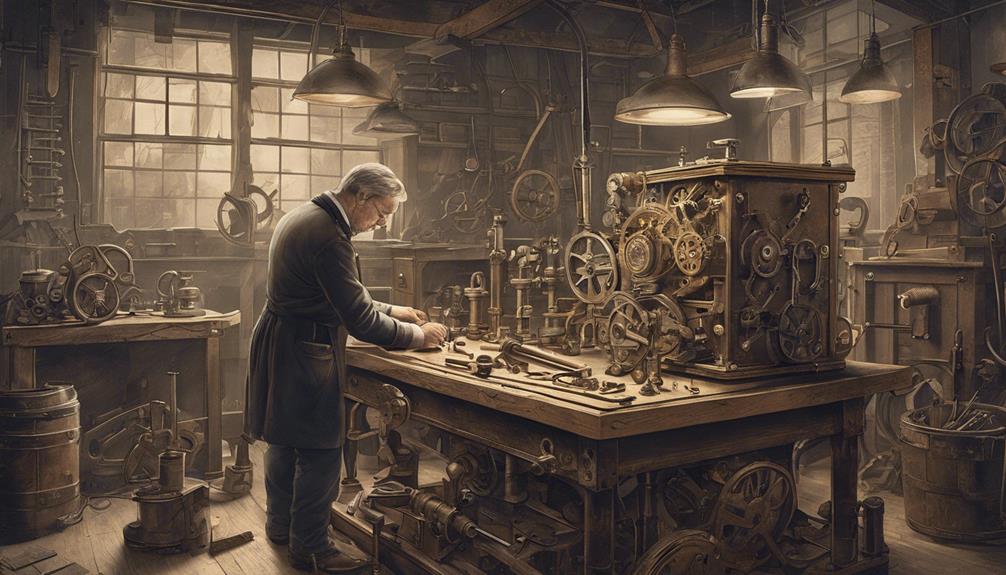
John Chubb, a distinguished figure in the 19th-century security landscape, revolutionized lock and safe technology with his innovative designs. His creation of the Chubb Detector Lock not only set new benchmarks in safeguarding but also demonstrated an unyielding commitment to preventing unauthorized access. Chubb’s legacy continues to influence modern high-security lock installations and safe locksmith services, underscoring his lasting impact on the industry.
Biography and professional achievements
Renowned for his groundbreaking contributions to the security industry, John Chubb’s 19th-century innovations in secure locks and safes set unparalleled standards in safeguarding valuables. Chubb’s expertise was evident in his meticulous designs, which incorporated intricate mechanisms to thwart unauthorized access. His passion for security led him to develop the renowned Chubb detector lock, a marvel of engineering that revolutionized the industry. This lock’s advanced key and lever system was celebrated for its robustness, establishing a reputation for being virtually unpickable. Chubb’s dedication to excellence not only protected countless assets but also elevated the standards of security technology, making him a pivotal figure in the history of lock and safe development. His legacy endures through the continued relevance of his innovations.
Development of the Chubb detector lock and secure safes
The Chubb detector lock, featuring an advanced step pattern key and multiple double-acting levers, marked a significant breakthrough in the domain of secure locks and safes, setting unprecedented standards for tamper resistance and reliability. John Chubb’s innovative design required a special key to reset the internal levers after a break-in attempt, elevating security measures to an unparalleled level. This lock was considered unpickable for three decades, profoundly addressing the vulnerabilities of previous designs. Additionally, Chubb’s secure safes, incorporating this advanced locking mechanism, provided exceptional protection for valuables. His contributions revolutionized the security industry, creating a benchmark for high-security mechanisms that safeguarded countless assets and offered peace of mind to those relying on his inventions.
Influence on the security industry and legacy in lockmaking
Pioneering advancements in lockmaking, John Chubb‘s innovative designs have left an indelible mark on the security industry, establishing foundational principles that continue to influence modern lock and safe technologies. Chubb’s development of the Chubb detector lock, famed for its unpickable nature for three decades, revolutionized the field. Featuring multiple double-acting levers and a unique step pattern key, his design introduced unprecedented levels of security. The necessity of a specific key to reset the levers after unauthorized attempts added a layer of complexity that became a benchmark for secure locks. Chubb’s legacy as a transformative figure in lockmaking is cemented by these pioneering designs, which continue to inspire and set standards in today’s high-security locking mechanisms.
Link to services such as safe locksmith services and high-security lock installations
In today’s world of high-security lock installations and safe locksmith services, John Chubb’s groundbreaking innovations serve as the cornerstone for advanced security solutions. Chubb’s introduction of the detector lock, featuring multiple levers and a distinctive key pattern, greatly enhanced the security of safes and valuable assets. His design, which required a specific key to reset the levers after any tampering, made unauthorized access exceedingly difficult, maintaining its unpickable status for three decades. Modern locksmith services and high-security lock installations draw heavily from Chubb’s pioneering work, ensuring robust protection against break-ins. His contributions have set enduring standards, enabling contemporary security professionals to implement sophisticated, reliable systems that continue to safeguard our most treasured belongings.
Conclusion
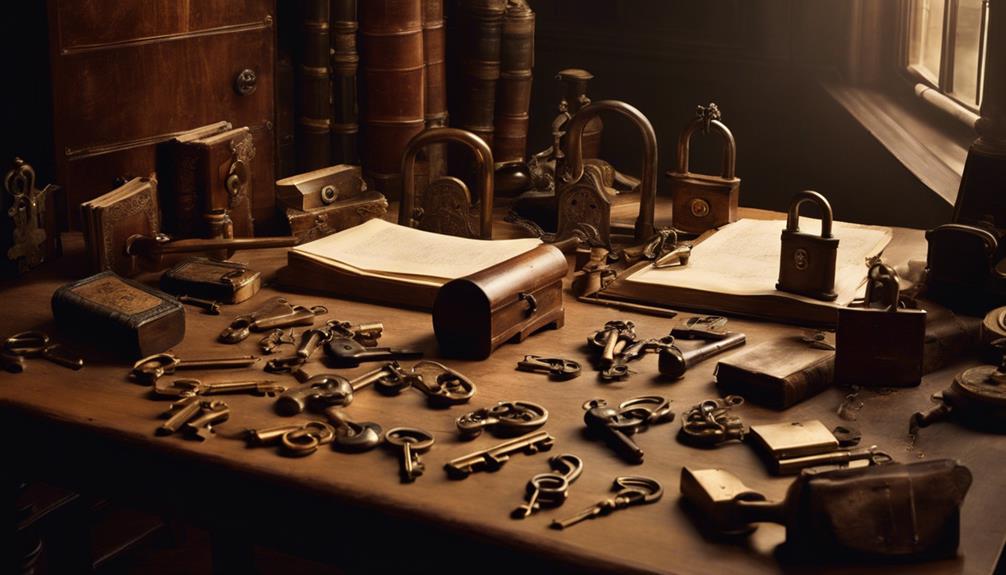
To conclude, the groundbreaking contributions of historical figures like Linus Yale Jr., Joseph Bramah, and Alfred Charles Hobbs have fundamentally transformed modern lock and security technologies. Their pioneering work has paved the way for contemporary innovations and inspired ongoing advancements in safeguarding techniques. For those seeking the latest in security solutions, exploring Low Rate Locksmith services is highly recommended, and further insights can be gained from related blog posts on locksmith services and security products.
Summary of the contributions of these historical figures to the field of security and locksmithing
The collective contributions of Linus Yale Jr., Abraham O. Stansbury, Joseph Bramah, Robert Barron, and Jeremiah Chubb have profoundly transformed the field of security and locksmithing, laying the technical foundation for modern advancements in lock mechanisms and safeguarding techniques. Linus Yale Jr.’s modern pin tumbler lock revolutionized security in 1860, while Abraham O. Stansbury’s 1807 patent for the double-acting pin tumbler lock drew inspiration from ancient innovations. Joseph Bramah’s H-cut lever lock in the late 18th century and Robert Barron’s double-acting lever lock introduced pivotal security enhancements. Jeremiah Chubb’s 19th-century detector lock with step pattern keys ensured unauthorized access prevention. Their groundbreaking innovations have collectively strengthened and advanced the domain of locks and security.
Reflection on how their innovations have shaped modern lock and security technologies
Building upon the pioneering innovations of historical figures like Linus Yale Jr., Abraham O. Stansbury, Joseph Bramah, and Jeremiah Chubb, modern lock and security technologies have greatly evolved to incorporate sophisticated mechanisms and digital integrations, ensuring robust protection against unauthorized access. Yale’s pin tumbler lock remains a cornerstone, inspiring advanced biometric and electronic locking systems. Stansbury’s double-acting pin mechanism and Bramah’s H-cut lever lock principles persist in high-security applications, now enhanced with digital encryption. Chubb’s detector lock concept has been reimagined in smart locks with real-time monitoring. Alfred Hobbs’ exposure of vulnerabilities has driven continuous advancements, solidifying our current security landscape. These innovations collectively form the bedrock of today’s cutting-edge security solutions, blending tradition with technology seamlessly.
Encouragement to explore Low Rate Locksmith services for cutting-edge security solutions
As we appreciate the historical milestones that have shaped modern security technologies, it’s equally important to explore the advanced, reliable services offered by Low Rate Locksmith for all your residential and commercial security needs. Their cutting-edge solutions encompass a wide range of locksmithing expertise, including precise lock installation, meticulous repair, and thorough maintenance. Prioritizing customer satisfaction and robust security, Low Rate Locksmith guarantees that your property is fortified with the most modern and efficient locking systems available. Additionally, their 24/7 emergency services guarantee prompt assistance, providing peace of mind in urgent lock-related situations. By choosing Low Rate Locksmith, you are investing in a secure future, backed by professional, reliable, and innovative security solutions designed to meet your unique needs.
To further your understanding of locksmith services and security products, we invite you to explore our related blog posts, which offer in-depth analyses and expert insights into the latest advancements and historical contexts of modern security solutions. Our expertly crafted content explores the pioneering contributions that have revolutionized lock and safeguard technology, providing you with a detailed view of how historical figures have shaped today’s security landscape. Discover the innovative ideas and advancements introduced by these trailblazers, and gain valuable insights into their enduring legacies. Whether you are a security aficionado or a curious enthusiast, our blog posts promise to enrich your knowledge and appreciation for the intricate world of locks and security systems.
Frequently Asked Questions
How Did Ancient Civilizations Secure Their Valuables Before Modern Locks?
Ancient civilizations employed ingenious methods to secure their valuables before modern locks. Egyptians utilized wooden pin and bolt locks, while Greeks favored wooden bolt locks. Romans pioneered metal padlocks, enhancing security. These mechanisms safeguarded treasures in temples, tombs, and treasuries. Over time, the designs evolved from simple to sophisticated, reflecting a profound understanding of security needs and an impressive level of craftsmanship and innovation in ancient lock-making.
What Materials Were Early Locks Typically Made From?
Just as a master painter selects the finest brushes, early locks were meticulously crafted from materials like wood, iron, and bronze. Wooden locks, dating back to ancient civilizations, were the precursors, while iron offered durability and bronze provided strength and corrosion resistance. With the evolution of technology, brass and steel became preferred, offering enhanced security and longevity. These materials were essential in securing valuables, reflecting an age-old pursuit of protection.
How Did the Industrial Revolution Impact Lock Development?
The Industrial Revolution profoundly transformed lock development by introducing mass production, which made locks more accessible and affordable. Innovations in manufacturing techniques enabled the creation of more intricate and secure designs. Machinery and standardized processes greatly enhanced the efficiency and output of the lock industry. Additionally, the advent of key-making machines streamlined key production, thereby democratizing advanced security features for a wider population. This era marked a pivotal shift in lock technology.
What Role Did Locksmith Guilds Play in Lock Advancements?
Locksmith guilds were pivotal in advancing lock technology through rigorous training, ensuring high-quality craftsmanship, and fostering innovation. These guilds maintained exclusive knowledge and specialized tools, which facilitated the development of more sophisticated locks. By promoting collaboration and shared expertise among members, guilds greatly contributed to technological progress in the field, ensuring security mechanisms evolved to meet increasing demands for protection and reliability. Their influence endures in modern security practices.
Are Any Historical Locks Still in Use Today?
Just as ancient trees still bear fruit, historical locks like the Egyptian pin-tumbler, Chubb detector, and Yale cylinder locks remain in use today. These venerable designs, rich in innovation, form the backbone of contemporary security. Lever locks and double-acting pin tumbler mechanisms, refined by pioneers, continue to safeguard modern treasures. Their enduring legacy testifies to timeless ingenuity, ensuring our most prized possessions remain secure.





